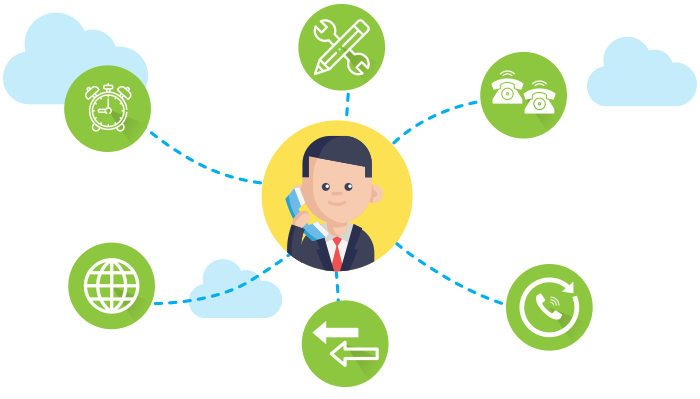Are you looking to improve caller experience when customers contact your business? Responsive phone support is crucial to increasing caller satisfaction.
And one way to make your business reachable and responsive is with call routing. Try different advanced call center routing strategies to reduce wait times and help callers reach the right department or employee quickly.
Call Routing Explained
Call routing is a call management tool that distributes incoming calls based on rules set by your business. In other words, you can set rules to route incoming calls to specific employees, offices, departments, or phone lines, as needed. This can help you manage high call volumes.
For example, you can set a rule to route calls coming to your main office to another location (such as a satellite office) during certain hours of the day. Or, you can set a rule to route calls coming from certain locations to a remote worker in that time zone or region.
These routing strategies help you organize incoming business calls during on and off-hours. And you can ensure callers are taken care of even outside of your regular business hours.
How Does Advanced Call Routing Work?
Advanced call routing is also referred to as an automatic call distributor system (ACD) since it automatically distributes calls to the right person or department. Callers do not have to input extensions. When they call a business, they may interact with a cloud IVR system or auto-attendant. Based on the rules set, the IVR will automatically route the calls or ask for more information about the caller and then route the call to the right department.
Benefits of Using a Global Call Routing Service
But what are the benefits of advanced call routing for your business? By routing calls strategically and effectively, you can help callers get assistance quickly. This improves customer experience as they don’t have to wait in long lines or move from employee to employee just to get information. And you can improve the overall experience of your customer support and sales teams by dividing the work and spreading it evenly.
Here are some of the key benefits of using a global call routing service:
- Route callers to the right person or department; eliminate confusion
- Offer 24/7 follow the sun customer support
- Provide global customer support
- Reduce wait time and call abandonment rates
- Reduce the number of missed calls
- Connect callers with agents within their time zone or location
- Connect callers with employees they have previously interacted with
- Improve customer satisfaction
- Offer virtual voicemail and self-service options
- Add custom greetings and pre-recorded messages
- Balance out employee workload

Call Routing Strategies and Best Practices
There are a few different ways to route calls coming into your business. This mainly depends on what you are trying to accomplish and the size of your business and customer-facing teams.
Once you have these basics down, you can start identifying routing strategies that fit within your infrastructure. You can route calls through an IVR system or ACD system with pre-set rules and pre-recorded messages. Here are the top call center routing strategies:
1. Time-Based Routing
With time-based routing, you can route calls to specific offices, lines, or employees based on the time of the call. For example, calls that come in during off-hours or the weekends can be directed to remote workers or employees in different time zones. This type of routing is also known as time of day routing.
2. Location-Based Routing
Route calls based on the location of the caller. This is a good strategy for businesses that have customers in multiple regions and countries around the world. You can group together regions within the same time zone or close by. And then forward incoming calls coming from customers within these regions to agents assigned to these regions. You can also forward calls internationally to different offices or locations with an international call routing service.
3. Skill-Based Routing
This strategy works along with your IVR system. The IVR system presents the caller with a menu of options to choose from. Based on the caller’s input, the system routes the call to the agent with skills that match the caller’s input. For example, customers needing assistance in specific languages can converse with employees fluent in those languages by opting for that option within the IVR.
4. Simultaneous Routing
With this routing feature, you can ring multiple phones with one number. This means incoming calls ring on all phones assigned within your hunt group or ring group. You can set your ring group to include employees in the main office, satellite offices, remote workers, and so on. Then, as a call comes in, whoever is available can jump in and assist the customer. The customer won’t have to wait for an available line.
5. Sequential Forwarding
Sequential Forwarding — also known as sequential ringing — delivers incoming calls down a predetermined list of numbers. If the employee assigned to the first number doesn’t answer it, the call moves to the next in line.
6. Round Robin Call Routing
The round robin routing strategy is the most common one. Most businesses start out with this routing technique and then evolve from there. This routing strategy helps distribute incoming calls evenly. The first call goes to the first employee in the predetermined list. The second call goes to the next person on the list, and so on. Once the last person on the list receives a call, the next call is sent to the first employee.
7. Least Occupied Agent Routing
With this strategy, calls are routed to the agent waiting for the longest. In other words, the call is sent to a line that hasn’t received a call in a while. This routing strategy ensures that no agent stays idle for too long. And distributed calls evenly among agents.
8. Holiday Rules
Set call forwarding rules for major holidays in advance. Calls coming in on these days can be forwarded to voicemail or office different locations. This way, callers can leave a message or get a response from your teams in other countries and time zones, when your main office or core employees are on vacation.
Get Advanced Call Routing with Global Call Forwarding
The call center routing service from Global Call Forwarding is highly customizable. So, you can design a phone system that works best for your needs. Map out different ring groups. Set up rules for different situations and times. Upload voice messages, custom greetings, and menu options. And create a better caller experience for your customers. Speak with our experts to learn more about what our service can do for your business. Call us at 1 (888) 908 6171 or chat with us online!


